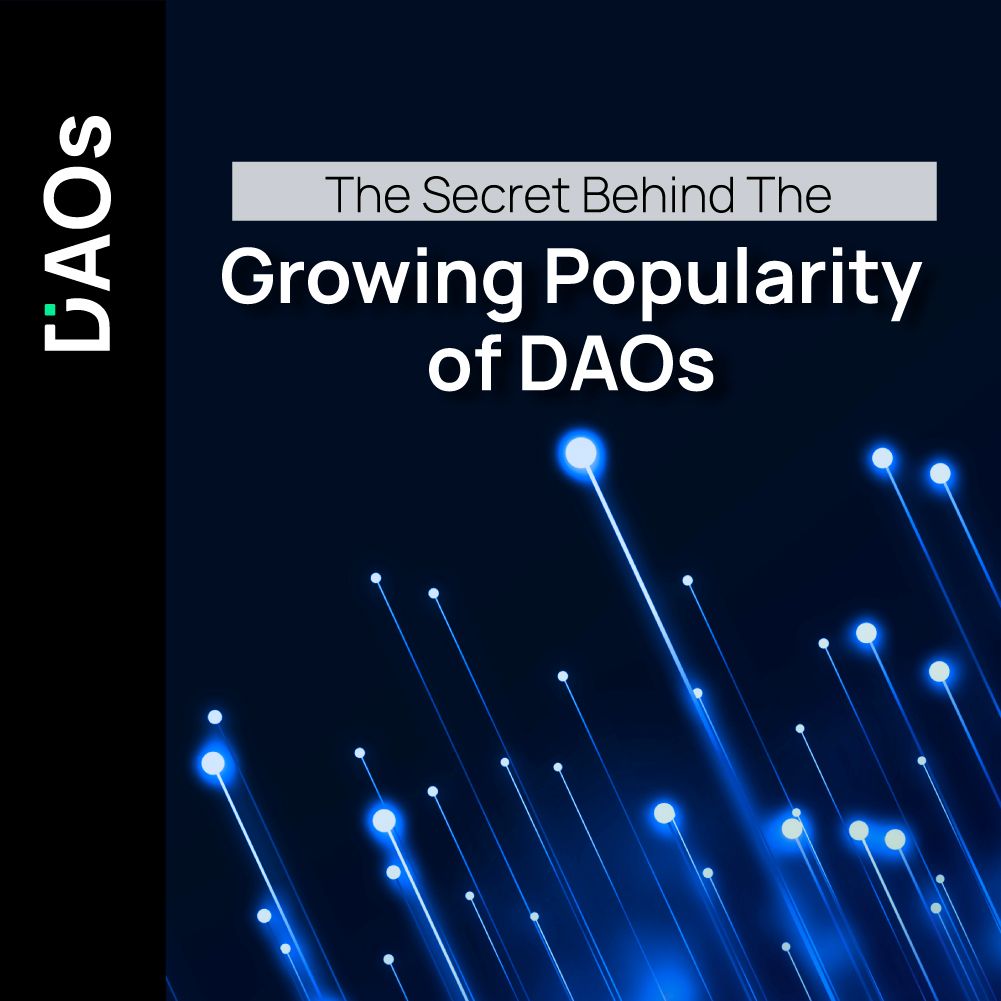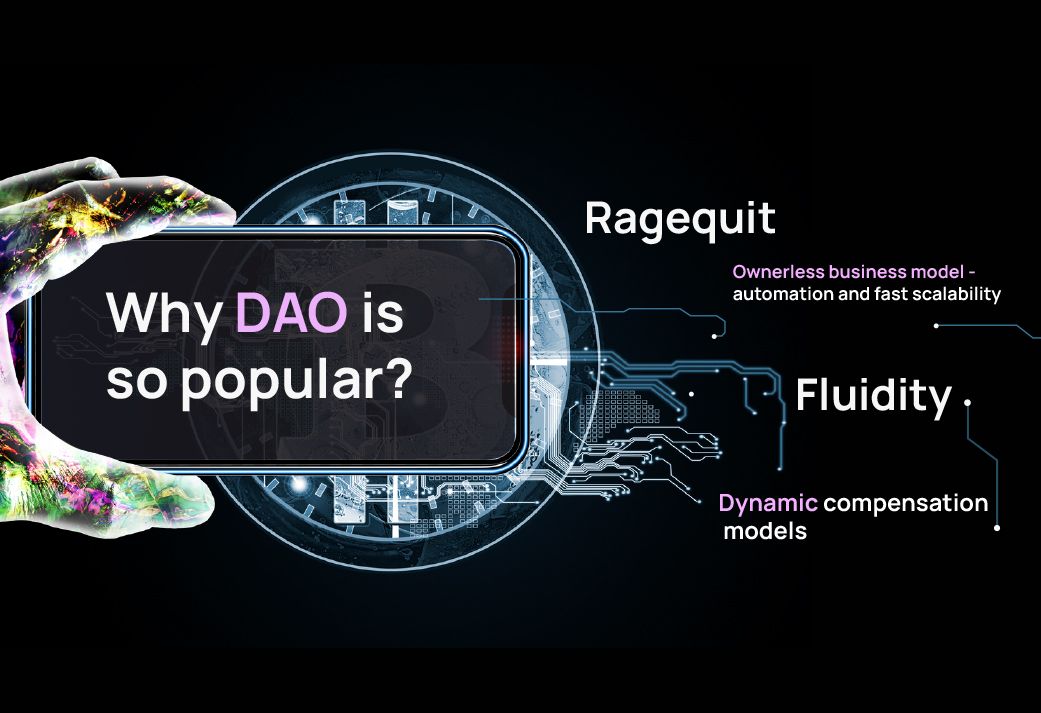02: The secret behind the growing popularity of DAOs

Deconstructing the craze and why it matters.
DAO, or Decentralized Autonomous Organization, is the new buzzword in the crypto ecosystem. Its low-cost, high-output model is inviting attention from every domain, and the mushrooming of DAOs worldwide is testimony to that.
What are DAOs exactly?
Unlike a company, which is run top down by a CEO, board or senior management, a DAO is a bottom-up organization where members of the DAO make decisions for the organization.
So what's the real reason for the sudden popularity of DAOs?
The answer may lie in the A of DAOs.
DAOs are autonomous organizations, and it is the smart contracts that allow the DAO to be run autonomously. Think of it as a vending machine. You put in a dollar, and get a soda immediately as opposed to ordering the soda and having a server get it for you. DAO token holders commonly vote on, among other things, the adoption of a particular smart contract, which is basically a code that self-executes once the vote is tabulated.
What makes DAOs really inviting are these smart contracts that offer speed, efficiency, accuracy, transparency, and security because they occur on the blockchain.
DAOs are a fundamentally new way of organizing and investing.
At the core of DAOs, lies the democratization of decision-making and value, and these concepts are radically new in the world of business. This almost egalitarian approach is exciting as it creates a possibility of a fair, transparent world, with power in the hands of all.
Here are some of the processes within a DAO that makes it uniquely compelling.
The Formation Process
Just like traditional organizations, a DAO is formed by a person or group of people to bring a new solution or innovation to the public. But unlike traditional organizations, DAOs require no formal procedures or paperwork. All it needs is a place where all members can gather virtually, such as Telegram or Discord channel. Then, the members agree to rules and write the code of smart contracts onto a blockchain. This cements the DAO's rules and member roles.
Funding Process
Funding for traditional organizations comes from loans, investors, or even crowdfunding. The investors have expectations and influence the organization's functioning because they own it.
But DAOs obtain funds differently. It starts with the creation of its unique DAO token. Next, it becomes publicly available and allows the buyers to own a stake in the DAO, based on how many tokens they hold.
Instead of a bank account, the funds would be stored in a multisig or multi-signature wallet, which requires many people's consent before one can transfer funds. This ensures that there are no superpowers within the DAO. The crypto DAO token buyers are not mere members but owners.
Organizational Structure
Traditional organizations stay alive due to their hierarchical structures. There's little 2-way communication; the top management decides, and the employees follow instructions, with little sense of autonomy, if any,
DAOs, on the other hand, have a flat hierarchy. There are no authoritarian forces calling the cards. Instead, each member can cast their vote, express opinions without fear, and participate in decision-making.
Smart contracts written on the blockchain are open source or fully transparent. All members can view the processes going on. Further, discussions within the DAO happen on Discord or Telegram channels, allowing open dialogue and a level of transparency that is beyond traditional organizations.
New organizational features unique to DAOs
Besides these features, DAOs are re-writing some of the rules of the business when it comes to company exits, business agility, and ownership models.
Let's dive into them and see how.
Ragequit
Many DAOs implement a function called Ragequit in their smart contracts. With Ragequit, when a member decides to leave a DAO and wants to exit from all associations with the DAO, they can do so with ease. And they can claim their share of assets on a pro-rata basis.
This is unheard of in the traditional front, where assets are tough to split up and might involve complex legal scenarios. On the contrary, if someone decides to ragequit, there are no papers signed, no double-checks, no negotiations, and no interventions by other members.
This feature has been used in the Moloch DAO framework and is found in all DAOs that follow such a structure.
Fluidity
DAO membership offers excellent fluidity. With paperwork and legal loopholes out of the equation, DAOs achieve a level of fluidity above and beyond traditional structures. For instance, a DAO member can do anything from managing assets, voting on community issues, and creating niche activities like art collection to building protocols.
Besides, the voting power granted to all token owners allows members to enjoy greater decision-making power. This scales the potential of organizations.
Compound Finance is a perfect example where you can see DAO fluidity and scalability at play. It is a money market created over the Ethereum blockchain. Users can put in money as collateral and borrow money or crypto in return. It also lets people earn interest on the collateral. The DAO has native tokens, and owners acquire voting rights based on the tokens they own. Plus, it functions based on an algorithm, no one can censor it, anyone with an internet connection can access it, and it stands on a firm ground of audited codes.
Greater freedom
With monotonous tasks out of their way, DAO members can be more creative. They can handpick projects that really matter to the values of the DAO and those that align with their strengths. This reduces work-life conflicts and mental stress.
On top of this, all DAOs allow remote working. Employees can choose any workplace with internet connectivity, and no questions will be asked.
Ownerless business model - automation and fast scalability
DAOs successfully eliminate human inputs wherever possible. This is enabled through smart contracts, which automate essential and non-essential practices as much as possible. By stringing together multiple smart contracts in a web of 'if' and 'then' statements, human intervention is minimized. This leaves more room for creativity, innovation, and more community-oriented activities that help scale the DAO.
Dynamic compensation models
DAOs have also introduced new compensation structures keeping in mind that not all contributors may be working on a full-time basis.
Most people in DAOs execute individual tasks, and these members get compensated in a 'work-to-earn' model (based on the amount of work done). Additionally, they can choose to get paid in the form of the native crypto DAO tokens or fiat currency. Token holders can choose to stake their token by depositing it in a central liquidity pool, earning an annual percentage yield on the side as well.
Another model is the 'play-to-earn' model, which is popular among teenagers. Take the example of Axie Infinity. It is a token-based game where players can win battles and earn the native token AXS. Unlike traditional games, players can own characters as NFTs and sell them on the native marketplace, possibly making profits.
A third structure is the 'learn-to-earn' model, like the one used by RabbitHole. Here you can earn by learning about Web3 applications.
Lastly, a 'create-to-earn' model is one where you can contribute articles or creatives to earn tokens.

The future is more autonomous
DAOs are by far the most profitable business model ever used, with the ability to work on the slimmest of margins. Yet they solve the shortcomings of traditional organizations through an ownerless model, where human effort is zero wherever possible.
The potential of ownerless businesses is yet to be fully discovered. But it is clear that DAOs will challenge and improve traditional business models at every level. The growth of AI will also be a big boost to DAOs, as it will complement their self-governance model.
Thanks to DAOs, we are looking at a real possibility of autonomous businesses looming large on the horizon.

